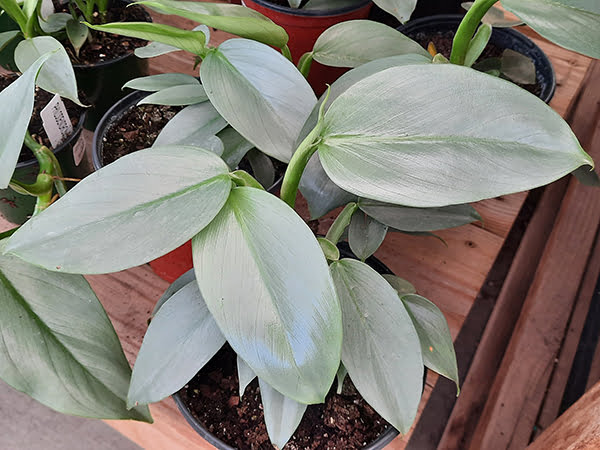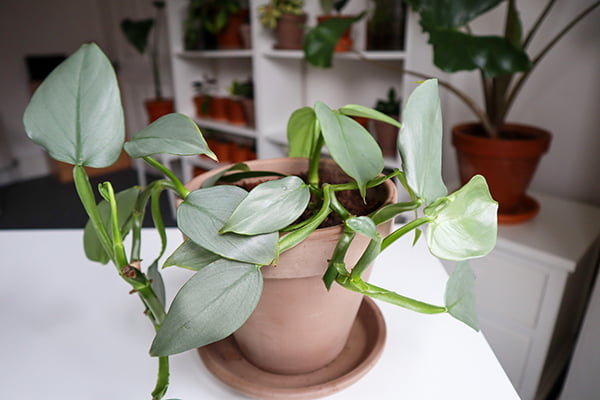The silver sheen on the leaves of the Silver Sword Philodendron makes it a favorite with any plant lover! This aroid plant is easy to care for, and it's becoming rare as its natural habits fall to deforestation. Thankfully, Silver Sword Philodendron has adjusted well to becoming an indoor plant, and everyone can enjoy the metallic shine on its beautiful leaves! Below, we'll tell you all about Silver Sword Philodendron care.
What Is A Silver Sword Philodendron?
Silver Sword Philodendron (Philodendron Hastatum) is an endangered species of Philodendron plant in the wild. It is native to South America and Australia, where this climbing vine scales taller trees. The rare plant has exceptional silvery leaves that are shaped like silver swords! These leaves hang from thick stems and will shift from a lance shape to an arrowhead shape as each leaf matures. Silver Sword Philodendron grows quickly, so be sure to support the vines with a moss pole or other support structure. Alternatively, you can use it in hanging baskets.
Botanical Name
Common Name
Plant Type
Mature Size
Sun Requirement
Soil Type
Hardiness Zone
Pet Friendly
Philodendron hastatum
Silver sword philodendron
Hemiepiphytic plant
10 Feet tall
Bright, indirect light
Well-draining
9b- 11
No
Silver Sword Philodendron Care Requirements
Light
Silver Sword Philodendron is native to tropical rainforests, where the plant grows underneath the canopy of large trees. It would receive an abundance of bright, indirect light as it filtered through the leaves! Direct sunlight will cause the leaves to burn. In fact, it's better to err for too little light rather than too much sunlight. Silver Sword Philodendrons can handle lower light conditions than other Philodendron varieties. Consider placing it near a north-facing window or east-facing window where the morning sun is mild. Avoid any location that receives direct afternoon sun.
Water
It's important not to overwater Philodendron Hastatum plants. They like moist soil but not saturated soil. Always check the plant's soil prior to watering by sticking your finger 2 inches into the soil. If the soil is dry, water your plant. The Silver Sword Philodendron can handle more water than other Philodendrons, so when you water it, give it a good drenching. Water it until you see excess water drain out from the drainage holes at the bottom of your pot.

Source: Flickr
Temperature
Like all tropical plants, Philodendron Hastatum needs warm temperatures, and the ideal range is between 65 and 80 degrees Fahrenheit. If temperatures dip below 55 degrees Fahrenheit, this frost-sensitive plant will die. Avoid locations in the house with a colder temperature than you might realize, like near an air conditioner vent or a drafty window.
Humidity
Philodendron Silver Sword is a tropical plant and requires high humidity levels to thrive. Your home likely does not have the required minimum of 60% humidity, but it's easy to boost the air moisture around your plant. Here are some ways:
Use a humidifier
You can use a humidifier to increase the air moisture of a whole room or a small one set next to your plant.
Misting
Mist the leaves with filtered water regularly. Take care, however, not to overdo it, or you could find yourself with fungus issues!
Set your plant on a pebble tray
Fill a tray with pebbles, then fill the tray with water. The water should not come up over the top of the pebbles! As the water in the tray evaporates, it increases the humidity around the plant.
Place it in the bathroom
Place your Philodendron Hastatum in a bathroom. It's typically the most humid room in the house!
Soil
Nearly any well-draining soil works well for your Philodendron Hastatum. However, the best Silver Sword Philodendron soil has additives to help balance water retention with ample drainage. Add compost, earthworm castings, or other organic matter to your potting medium for nutrients. Mix in coco coir, orchid bark, perlite, or pumice for aeration and soil drainage. Use small amounts of sphagnum peat moss for slow-releasing water retention.
Fertilization
While not strictly necessary, fertilizing your Philodendron Silver Sword regularly will encourage healthy foliage growth. Apply a slow-release, balanced fertilizer every 2 to 3 months. After applying, water your plant thoroughly to help spread the fertilizer throughout the soil and avoid burning the plant's roots at the top of the pot.
Propagation
The main way to propagate Silver Sword Philodendron is by using stem cuttings. Here's how:
Use clean shears to cut a 2 to 4-inch length of the stem. Be sure your stem cutting has at least one pair of healthy leaves near the tip, and cut directly below a leaf node. These leaf nodes can turn into aerial roots, but we're going to push them to grow into a healthy root system underground.
Set the stem cutting out in a warm place for a week so the cut can calluses. Then, dip it in the rooting hormone to encourage quicker and stronger propagating.
Plant the stem cutting in a small pot filled with loose soil. Keep the soil moist, and place it in a warm location that receives plenty of indirect sunlight. You can put a plastic bag over the top of the pot to boost humidity.
In six weeks, there will be fresh root growth, and you should notice new leaves! You can now begin to water it less frequently and fertilize it.

Source: Flickr
Common Problems
Philodendron Hastatum isn't a finicky plant to care for, but you should keep an eye out for a few pests and diseases.
Pests
This Philodendron species doesn't tend to attract pests. You might notice spider mites, mealybugs, and aphids. Treating the plant with neem oil regularly will take care of them.
Diseases
The Philodendron Silver Sword doesn't like overly wet soil. Wet soil suffocates its roots and leads to root rot. It's hard to catch root rot early because there aren't many early symptoms readily noticeable in the leaves. However, if your leaves are turning yellow and brown, you need to unpot your plant, cut away unviable roots, and repot in dry soil.
Leaf Troubles
Yellow leaves are a sign of overwatering, and yellowing leaves can also be a sign that your Philodendron Silver Sword isn't receiving enough humidity. If your plant leaves are yellow with brown tips, your plant is receiving too much light.
A leggy stem and droopy leaves likely mean your plant needs more sunlight.
Is the Silver Sword Philodendron Pet-Friendly?
No, Philodendron Silver Sword is toxic to both animals and humans, and this is due to its high concentration of calcium oxalate crystals found in both the stems and leaves. If ingested, these will lead to diarrhea, nausea, vomiting, skin irritation around the mouth, and swelling of the mouth and throat.

